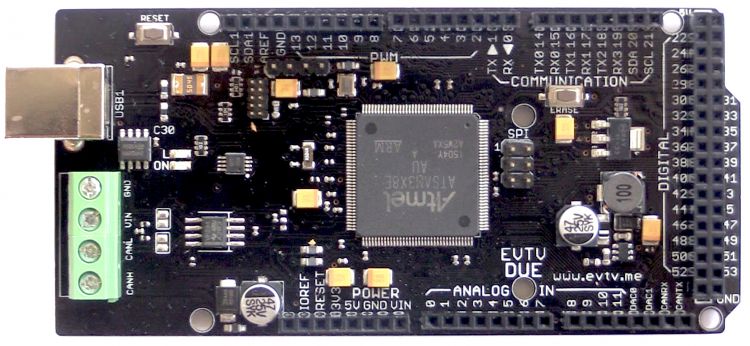Store Home
EVTVDue Microcontroller
EVTVDue Microcontroller
Arduino has released a new 32-bit ARM based version of their popular microcontroller they call the Arduino Due. It actually has TWO Controller Area Network (CAN) controllers built into it - but no transceivers. In a stunning second omission, Arduino Due provides NO EEPROM for persistent memory. You can't save variables from one power up to another.
So we have commissioned our own version - The EVTV CANDue Microcontroller. This single board replaces the fragile micro USB connectors with a single strong Mini-B printer style USB port on the native USB port to the microcontroller.
We've also added a 2Mbit EEPROM chip providing 256 Kbytes of persistent memory to save program data or configuration details.
AND most importantly, a Texas Instruments CAN transceiver on the board to enable the CAN controller in the SAM3X microcontroller chip allowing direct CAN communications.
|
Controller |
AT91SAM3X8E 32-bit |
| Working Voltage | 3.3V |
| Input Voltage (recommended) | 7-12V |
| Input Voltage(limited) | 6-20V |
| Digital I/O Pin | 54 (12 channel PWM output) |
| Analog Input Channel Pins | 12 |
| Analog Output Channel Pins | 2 (DAC) |
| IO Output Current | 130 mA (3.3V) |
| Output Capacity | 800 mA (5V) |
| Flash | 512 KB |
| SRAM | 96 KB ( 64KB and 32KB) |
| Frequency | 84 MHz |
| EEPROM | 256Kbytes |
| Length | 111.52 mm |
| Width | 53.3 mm |
| Weight | 36 g |
The Atmel | SMART SAM3X/A series is a member of a family of Flash microcontrollers based on the high performance 32-bit ARM Cortex-M3 RISC processor. It operates at a maximum speed of 84 MHz and features up to 512 Kbytes of Flash and up to 100 Kbytes of SRAM. The peripheral set includes a High Speed USB Host and Device port with embedded transceiver, an Ethernet MAC, 2 CANs, a High Speed MCI for SDIO/SD/MMC, an External Bus Interface with NAND Flash Controller (NFC), 5 UARTs, 2 TWIs, 4 SPIs, as well as a PWM timer, three 3-channel general-purpose 32-bit timers, a low-power RTC, a low power RTT, 256-bit General Purpose Backup Registers, a 12-bit ADC and a 12-bit DAC.
DUE_CAN LIBARY .EVTV CANDUE MICROCONTROLLER DOCUMENTATION
DUE_WIRE LIBARY .
WIRE_EEPROM LIBARY .
CANskeleton.ino
This example program allows you to use the EVTVDue CAN Microcontroller. It illustrates how to use the onboard EEPROM, and the CAN transceiver to send and receive CAN messages. Provides a good, and heavily commented starting point to develop more advanced programs for this device.
GVRET-PC.zip
This Generalized Vehicle Reverse Engineering Tool GVRET runs on CANDue to communicate with the SavvyCAN application program for CAN data capture and analysis.
If you need more information of SavvyCAN, please check on the website: https://www.savvycan.com and Collin's Github page: https://github.com/collin80/SavvyCANSavvyCAN LINUX SavvyCAN is a desktop CAN analysis program - run on any laptop connected to CANDue running GVRET for a full CAN data analysis tool. Linux Version
SavvyCAN OS X SavvyCAN is a desktop CAN analysis program - run on any laptop connected to CANDue running GVRET for a full CAN data analysis tool. Mac OS X 64bit Version
SavvyCAN Windows 64 bit SavvyCAN is a desktop CAN analysis program - run on any laptop connected to CANDue running GVRET for a full CAN data analysis tool. Windows 64 bit version.
SavvyCAN Windows 32 bit SavvyCAN is a desktop CAN analysis program - run on any laptop connected to CANDue running GVRET for a full CAN data analysis tool. Windows 32 bit version.
Couldn't load pickup availability

